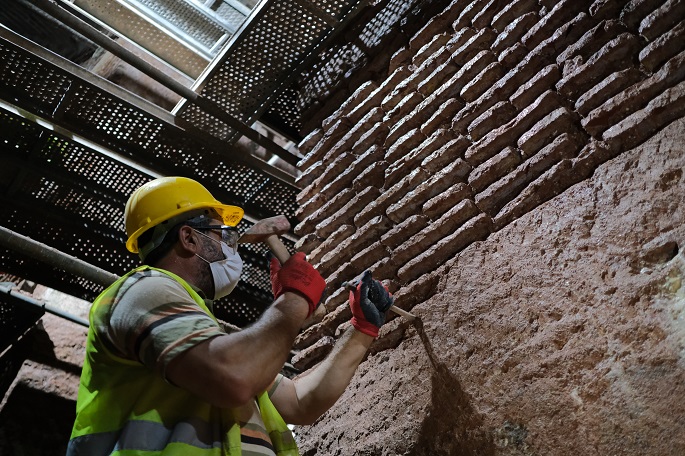Istanbul's magnificent 6th century "Sunken Palace" gets face-lift
Published : 29 Aug 2020, 23:58
Resul Kodak, chief of the restoration team, started his daily work at an underground structure in Turkey's biggest city Istanbul at eight o'clock in the morning after putting his protective construction helmet and goggles on.
"We should not forget that we are working in an ancient structure," he told his team members in the Basilica Cistern. "We need to be very careful. A single wrong hit of our hammer can cause great damage in this one of the most magnificent constructions in the world," Kodak said.
Covering 9,800 square meters of area in total, this giant water reservoir was built in the 6th century during the reign of the Byzantine Empire, and could once store up to 100,000 tons of water.
It is also known as the "Sunken Palace" because of its beautiful 336 marble columns, each nine meters high, rising from the water, creating an image of eternity. The head of these columns bears several features adorned with different motifs of the Corinthian and Dorian styles.
A year ago, an extensive restoration process, which also includes strengthening works against earthquakes, has begun in the cistern, which now functions as a museum, hosting numerous national and international events, concerts, and performances.
"We are working with great responsibility, carrying out this process with competent experts and highly skilled workers," Oktay Ozel, manager for the Istanbul Municipality Directorate of Cultural Heritage Projects, told Xinhua.
"We started the entire process by conducting some scrapper activities and removing cementitious elements," Ozel talked about the details of the restoration works. "Currently, there is a grouting opening activity in brick pillars. The original bricks have been reached on the floors, and their conservation work is being done."
He said the team is now at the final stage of the process, which is expected to be completed within six months.
The manager also noted that the municipality has been developing a new museum project inside the cistern in cooperation with Italian officials and experts.
"We will share the details with the public in the coming days," he said, refusing to give some hints about the theme of the museum.
Ozel stressed that there has been a sharp decrease in the number of visitors due to the COVID-19 pandemic, but he has high hopes for the future as the new museum project would create a worldwide attraction center.
Meanwhile, due to the pandemic, the restoration activities have been slowed down deliberately, aiming at following the social distancing rule at a maximum level, according to the officials.
"Despite the large size of the venue, we are actually in a closed area here. That's why we have to pay maximum attention to the distance," an architect who was monitoring the team told Xinhua.
"When the workers work side by side, they can finish the job quickly simultaneously. But now they are conducting their activities in solo, so the work gets slower," the architect said.
The cistern has been subjected to repeated renovations and repairs since its establishment.
However, experts agree that this latest one will leave a mark in the history of this ancient venue, which has also hosted some unforgettable scenes of several movies over the years, including the James Bond series "Skyfall," Australian actor Russell Crowe's "The Water Diviner" and the film adaptation of the American author Dan Brown's novel "Inferno."
In the meantime, Kodak and his team of 14 finished their daily jobs at five o'clock in the afternoon. They have got tired but are content as they did what they love to do.
"There is no difficulty in this job for us. We have been doing it for years with love," he noted. "We concentrate on our work in the same way as a football player prepares for a derby."


